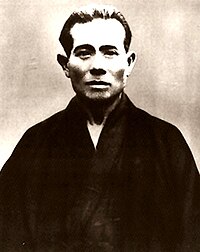1. Identify five major Goju-Ryu lineages after Miyagi and their respective founders.
Jundokan

Eiichi Miyazato
- Born: 5 July 1922, Naha, Okinawa Prefecture, Japan
- Died: 11 December 1999, Okinawa Prefecture, Japan
- In 1957, Miyazato opened his own dojo, the Jundokan
Shoreikan

Seikichi Toguchi
- Born: May 20, 1917 in Naha City, Okinawa
- Died: Japan – August 31, 1998 in Tokyo)
- In 1954 Toguchi opened up the first Shorei-kan dojo

Seiko Higa
- Born: 8 November 1898, Naha, Okinawa Prefecture, Japan
- Died: 16 April 1966, (?)
- In 1960 Higa founded Goju-ryu Kokusai Karate Kobudo Renmei (“Goju-ryu International Karate Kobudo Federation”)
Meibukan

Meitoku Yagi
- Born: 6 March 1912, Naha, Okinawa Prefecture, Japa
- Died: 7 February 2003, (?)
- Yagi opened his own dojo in the Daido district of Naha. He named his school of Goju-ryu Meibukan
Goju-Kai

Gogen Yamaguchi
- Born: January 20 1909, Miyakonojō, Miyazaki, Japan
- Died: May 20 1989, (?)
- In 1935 he officially formed the All Japan Karate-dō Gōjū-kai Association, which later split into the JKF Gojukai and the J.K.G.A
2. What does the last karate precept of Funakoshi’s ‘20 Commandments‘ mean to you?

3. What does “karate ni shente nashi” mean?
4. What are the three fundamental karate kumite strategies?
- Go no sen – To defend after the opponent has attacked to completion. Typically, is an uke technology follow by a tori technology.
- Sen no sen – To defend and counter attack while the opponent is attacking. This requires superb reflexes and explosiveness to get the timing right.
- Sen sen no sen – To defend by anticipation. Attack just before the opponent has initiate the attacked.
5. What are Mabuni’s “Uke no henka”?

Rakka: Like a falling flower
To block with such force that if the technique were applied to the trunk of a tree it would lose all of its flowers. A block should be executed so decisively that it not only halts an opponent’s attack but utterly defeats it with a single technique.
 |
 |
| Uchi Uke | Yoko Barai |
Ryusui: Like flowing water
To flow with your opponents movements, using them against him and as an aid to your defense. Respond to your opponent using fluid movement.

Nagashi Uke
Kusshin: (“Darting out and in”) Control of an attack that uses body movement originating in the knees. Keep your spine straight and use your knees to control your height, giving you balance and the strength of your legs so that little effort is required to control the attack. Springing. A reflexive, darting “out and in” kind of body shifting from any angle.
 |
 |
| Shuto Uke | Kokutsu Gedan Barai |
Tenshin: Tai sabaki,(rolling the body by stepping out)
Essentially avoiding your opponent’s attack using body movement. Stepping out in all directions.

Shotei Uke
Hangeki: Counter attack
When the need arises, respond to your opponents attacks with decisive, powerful counter-attacks. By utilizing the first four principles you may never need to implement the fifth, but if required you should apply you whole mind and body to the counter.

Jodan Tsuki Uke
6. Which major karate style has the most number of katas and why?
It’s well known that shito-ryu is the style of karate with the largest number of kate because Mabuni Kenwa studied Naha-te and Shuri-Te arts under Hi-shi-gaonna and Itosu, therefore absorbing all the katas in both systems.
There are various branches of shito-ryu with anything from 40 to 60 different forms.
7. What is the relationship between To’on Ryu and Goju-Ryu?
8. What other name is Pangai noon known as?
Pangain noon could be translated as “half-hard, half-soft”, the style was renamed Uechi-Ryū after the founder of the style, Kanbun Uechi.

Kanbun Uechi
- Born: May 5, 1877 Motobu, Okinawa, Ryukyu Kingdom
- Died: November 25, 1948 (aged 71) Ie, Okinawa, Empire of Japan
9. What was Shito-Ryu called first and why?
10. Who were the grandparents of Shorin and Shorei Ryu, respectively, and when where they born and deceased?
Shorin-Ryu (Shuri-te)

Anko Itosu
- Born 1831, Gibo Village, Shuri, Ryūkyū Kingdom
- Died 11 March 1915, Shuri, Okinawa, Japan
Shorei-Ryu (Naha-Te)

Higaonna Kanryō
- Born March 10 1853, Nishimura, Naha, Ryūkyū Kingdom
- Died Oct 1915, Naha, Okinawa
